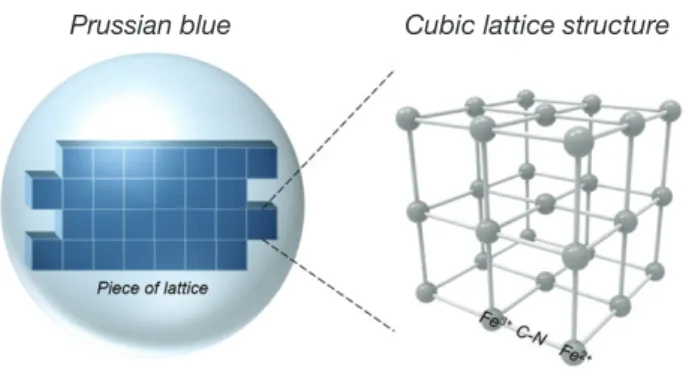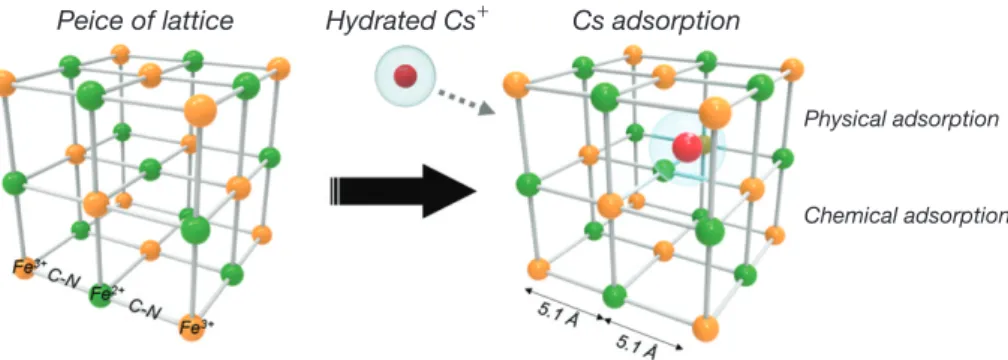서 론
방사성 세슘(137Cs)은 우라늄의 핵분열 과정에서 얻어지 는 방사성 물질이며, 베타선 붕괴와 강한 감마선 붕괴를 일 으키는 원소로써, 자연 상태에서는 존재하지 않았으나, 핵실 험과 원자력발전에 의해 인공적으로 발생된 원소이다(Yang et al. 2011). 강력한 감마선으로 암세포를 죽이기 때문에 병 원에서 자궁암 등의 치료에 사용되기도 하지만, 정상 세포 가 방사성 세슘에 노출이 될 경우 암 등이 유발할 수 있는 인체에 치명적인 방사성 물질이다. 인체에 흡수되면 배출이 잘 되지 않고, 주로 근육에 고농축되는데 골수암이나 폐암 등 각종 암을 비롯해 인체 내의 백혈구를 감소시켜 백혈병 을 유발할 수 있다. 2011년 일본에서는 지진의 여파로 지진해일이 발생하였 고, 이로 인하여 후쿠시마 원자로가 블랙아웃 상태에 빠져프러시안 블루
(PB)
의 방사성 세슘 흡착 메커니즘 연구
장성찬1,2· 김준영1· 허윤석1,* · 노창현2,3,* 1인하대학교 생명공학과, 2한국원자력연구원 첨단방사선과학연구소 생명공학연구부 3과학기술연합대학원대학교 방사선동위원소 응용 및 생명공학Adsorption Mechanism of Radioactive Cesium by Prussian Blue
Sung-Chan Jang
1,2, Jun-Yeong Kim
1, Yun Suk Huh
1,* and Changhyun Roh
2,3,*
1Department of Biological Engineering, Biohybrid Systems Research Center(BSRC), Inha University, Incheon 22212, Korea
2Biotechnology Research Division, Advanced Radiation Technology Institute(ARTI), Korea Atomic Energy Research Institute(KAERI), Jeongeup 56212, Korea
3Radiation Biotechnology and Applied Radioisotope Science, University of Science Technology(UST), Daejeon 34113, Korea
Abstract - Since the accident at the Fukushima Daiichi power plant, Prussian blue(PB) has attracted increasing attention as a material for use in decontaminating the environment. We have focused the fundamental mechanism of specific Cs+ adsorption into PB in order to develop
high-performance PB-based Cs+ adsorbents. The ability of PB to adsorb Cs varies considerably
according to its origin such as what synthesis method was used, and under what conditions the PB was prepared. It has been commonly accepted that the exclusive abilities of PB to adsorb hydrated Cs+ ions are caused by regular lattice spaces surrounded by cyanido-bridged metals. Cs+ ions are
trapped by simple physical adsorption in the regular lattice spaces of PB. Cs+ ions are exclusively
trapped by chemical adsorption via the hydrophilic lattice defect sites with proton-exchange from the coordination water. Prussian blue are believed to hold great promise for the clean-up of 137Cs
contaminated water around nuclear facilities and/or after nuclear accidents. Key words : Prussian blue, Adsorption, Lattice space, Proton-exchange
─ 127 ─
* Corresponding author: Yun Suk Huh, Tel. +82-32-860-9177, Fax. +82-32-872-4046, E-mail. yunsuk.huh@inha.ac.kr Changhyun Roh, Tel. +82-63-570-3133, Fax. +82-63-570-3139, E-mail. chroh@kaeri.re.kr
Technical Paper
장성찬·김준영·허윤석·노창현 128 이로 인하여 원자로 내부의 온도 제어를 통제하지 못하는 상황이 발생하였고 고온, 고압의 원자로가 폭발하는 사고가 발생하였다(Buesseler et al. 2011). 이 원자로 사고로 인하여 940TBq의 방사성 세슘이 환경에 노출되었으며(Yasunari et al. 2011; Hu et al. 2012a), 방사성 세슘의 환경에 미치는 영
향과 이를 제거하기 위한 관심이 커졌다. 특히 방사성 세슘 은 반감기가 30.2년에 이르며 인체 내에서 칼륨이온과 유 사한 체내 거동을 보이기 때문에 인체 내에 흡수될 경우 장 기와 근육에 쉽게 축척되며, 생물학적 반감기는 110일 정도 소요된다(Namiki et al. 2012). 후쿠시마 원전 사고로 인해 방사성 세슘에 오염된 물은 자생정화 능력으로는 긴 시간이 필요하기 때문에 효율적인 제거 방법과 흡착제의 연구의 필 요성이 대두되고 있다(Brumfiel 2011; Thammawong et al. 2013).
프러시안 블루(PB, Prussian blue)는 상업적으로 구입 가 능한 파란색을 띠는 염색용 시료이다. 프러시안 블루는 알 칼리 양이온에 대한 선택적 흡착이 가능한 소재로 알려져
있으며, 특히 방사성 세슘을 제거하는 데 효과적인 것으로
알려져 있다(Sangvanich et al. 2010; Chen et al. 2012). 후크 시마 원자력 발전소 사고 이후 프러시안 블루에 대한 관심 이 증가하였으며, 최근 방사성 세슘 흡착소재에 관련된 논 문에 많이 사용되어지고 있다. 본 논문에서는 방사성 세슘에 대한 선택적 흡착능력이 있 다고 알려진 프러시안 블루의 구조와 세슘 이온의 제거와 흡착 메커니즘에 대해 알아보고자 한다.
재료 및 방법
1. 제조법 프러시안 블루는 다양한 제조 방법으로 제조될 수 있음이 보고되어져 있다. 그중에 가장 일반적인 방법으로는 (1) Fe3+ 와 M4[Fe(CN)6]을 사용한 공침전법(Ishizaki et al. 2013), (2) Fe2+와 M4[FeII(CN)6]을 사용한 산화법(Samain et al. 2013), (3) M4[FeII(CN)6](Hu et al. 2009) 또는 M3[FeIII(CN)6](Torad et al. 2012)수열합성법 등이 존재한다(M은 알칼리 양이온). 프러시안 블루의 제조 방법에 따라 형태와 결정의 크기 조 절이 가능하다(Hu et al. 2012b). 2. 종류 프러시안 블루는 물에 대한 용해성에 따라서 두 종류로 구분한다. 일반적으로 프러시안 블루는 Fe3+와 [FeII(CN)6] 4-또는 Fe2+와 [FeIII(CN)6]3-의 결합으로 형성된다(Ishizaki et al. 2010). 불용해성 프러시안 블루는 FeIII4[FeII(CN)6]3로 구 성되며 용해성 프러시안 블루는 KFeIII[FeII(CN)6]로 표현된
다(Samain et al. 2013).
4Fe3++3[FeII(CN)6]4- →Fe4III[FeII(CN)6]3 (1) K++Fe3++[FeII(CN)
6]4- →KFeIII[FeII(CN)6] (2) 불용해성 프러시안 블루가 회수 공정이 쉽게 회수할 수 있기 때문에 흡착공정에 더 적합하다.
결 과
1. 프러시안 블루의 구조 프러시안 블루는 균일한 면심 입방 격자구조를 갖고 있으 며, 이상적인 구조는 FeIII :[FeII(CN)6]4-=1:1 구조를 갖고 있다(Ishizaki et al. 2013). 메탈이온은 시아노 그룹으로 연 결되어 있어서 양이온을 흡착시킬 수 있는 격자 공간이 존 재한다. 용해성 프러시안 블루는 격자 공간 안에 K+이온들 을 포함하고 있으며, 불용해성 프러시안 블루는 물 분자를 포함하고 있다. 기본 골격인 FeII-C-N-FeIII 결합거리는 5.1Å 이며, 정육각형 구조로 결합되어 있다. 2. 물리적 세슘 흡착 메커니즘 프러시안 블루에 대한 알칼리 금속 이온과의 흡착 성능은 알칼리 금속 이온의 수화상태의 크기와 관련이 있다. 따라 서, 알칼리 금속 이온의 흡착능력은 Cs+≫K+≥Na+으로 차 이가 생기게 된다. 이는 알칼리 금속 이온 중 프러시안 블루 의 격자 구조 크기에 잘 맞는 이온 반경을 갖는 이온과 흡 착력이 크게 나타난다(Pau et al. 1990). 알칼리 금속의 이온 반경 크기는 Cs+(1.19)<K+(1.25)<Na+(1.84Å)이며, Cs+ 의 이온 반경이 가장 작고 프러시안 블루의 격자 구조에 잘 맞아 흡착력이 높으며, 이는 프러시안 블루가 세슘을 선택 적으로 흡착하는 데 이점이 있다고 말할 수 있다(Ishizaki et al. 2013).Fig. 1. Chemical structure of Prussian blue.
방사성 세슘 흡착 메커니즘 129 3. 화학적 세슘 흡착 메커니즘 프러시안 블루 격자 구조 내부는 물 분자가 배위 결합하 여 채워져 있어 친수성 특성을 띄고 있다. 수화된 세슘 이온 은 프러시안 블루 내부의 친수성 공간에 흡착되기 쉽고, 또 한 세슘 이온이 프러시안 블루 내부 공간에 트랩이 되면 FeIII 이온의 배위결합 되어 있는 물 분자의 양성자 교환에 의해 세슘이 제거된다(Ishizaki et al. 2013).
FeIII-OH2+Cs+A-→{FeIII-OH}- Cs++H+A- (3) 양성자 교환 방법으로 Cs+ 이온을 효과적으로 프러시안 블루 내부의 격자 구조에 흡착시킬 수 있게 된다.
고 찰
본 논문에서는 프러시안 블루의 세슘 이온을 선택적으로 흡착할 수 있는 특성을 확인하였고, 이는 격자 구조의 크기 에 의한 세슘 이온의 선택적 흡착 능력 증가와 양성자 교환 메커니즘에 의한 세슘 이온의 고정화로 설명이 가능하며, 이를 통해 효과적으로 세슘 이온을 흡착 및 제거할 수 있음 을 설명하였다. 후쿠시마 원전 사고 이후, 방사성 세슘의 흡 착 및 제거에 관심을 갖게 되며 프러시안 블루에 대한 관심 이 높아졌으며, 효율적인 흡착소재를 만드는 데 프러시안 블 루가 활용될 수 있을 것으로 기대된다.결 론
프러시안 블루의 선택적 세슘 흡착 메커니즘에는 물리적/ 화학적 특성이 있음을 확인하였다. 프러시안 블루의 구조를 분석하여 물리적 흡착 메커니즘을 확인하였고, 결론적으로 균일한 면심 입방 격자 구조에 양이온의 흡착을 할 수 있으 며 격자 구조의 크기에 의해서 세슘의 흡착 효율이 경쟁 양 이온들에 비하여 높게 나올 수 있음을 확인하였다. 또한 화 학적 흡착 메커니즘으로 격자구조 내부의 물 분자들에 의해 수화된 세슘 이온들이 흡착이 되기 쉬우며, 이때 양성자 교 환 메커니즘에 의해 세슘이 격자 구조 내부에 흡착이 될 수 있음을 확인하였다. 따라서 프러시안 블루의 물리적/화학적 흡착 메커니즘의 시너지 효과에 의해 다른 양이온들에 비해 세슘이 흡착능이 높은 특성을 가지고 있는 흡착제임을 확인 하였다.사 사
이 논문은 미래창조과학부의 재원으로 방사선기술개발사 업의 방사선융합기술(공동응용)의 일환으로 지원을 받아 수 행된 연구로 이에 감사드립니다(NRF-2015M2A2A6A020 45263(2)).참 고 문 헌
Brumfiel G. 2011. Fukushima set for epic clean-up. Nature 472:146-147.
Buesseler K, Aoyama M and Fukasawa M. 2011. Impacts of the Fukushima nuclear power plants on marine radioactivi-ty. Environ. Sci. & Technol. 45:9931-9935.
Chen RZ, Tanaka H, Kawamoto T, Asai M, Fukushima C, Kurihara M, Watanabe M, Arisaka M and Nankawa T. 2012. Preparation of a film of copper hexacyanoferrate nanoparticles for electrochemical removal of cesium from radioactive wastewater. Electrochem. Commun. 25:23-25. Hu BY, Fugetsu B, Yu HW and Abe Y. 2012a. Prussian blue
caged in spongiform adsorbents using diatomite and car-bon nanotubes for elimination of cesium. J. Hazard. Mater. 217:85-91.
Hu M, Furukawa S, Ohtani R, Sukegawa H, Nemoto Y, Reboul
Fig. 2. Schematic PB structures consisting of 3-D regular lattice spaces surrounded by the FeII-CN-FeIII bonds in the case of a unit cell of
3×3×3 structure of Fe atoms. Cs+ions are trapped by simple physical adsorption in the regular lattice spaces.
Peice of lattice Hydrated Cs+ Cs adsorption
Physical adsorption
장성찬·김준영·허윤석·노창현
130
J, Kitagawa S and Yamauchi Y. 2012b. Synthesis of Prus-sian blue nanoparticles with a hollow interior by controlled chemical etching. Angew. Chem. Int. Edit. 51:984-988. Hu M, Jiang JS, Ji RP and Zeng Y. 2009. Prussian Blue
mesoc-rystals prepared by a facile hydrothermal method. Crys-tengcomm 11:2257-2259.
Ishizaki M, Akiba S, Ohtani A, Hoshi Y, Ono K, Matsuba M, Togashi T, Kananizuka K, Sakamoto M, Takahashi A, Kawamoto T, Tanaka H, Watanabe M, Arisaka M, Nanka-wa T and Kurihara M. 2013. Proton-exchange mechanism of specific Cs+ adsorption via lattice defect sites of Prus-sian blue filled with coordination and crystallization water molecules. Dalton T 42:16049-16055.
Ishizaki M, Gotoh A, Abe M, Sakamoto M, Tanaka H, Kawa-moto T and Kurihara M. 2010. Systematic Bathochromic Shift of Charge-transfer Bands of Mixed-metal Prussian- blue Nanoparticles Depending on Their Composition Ra-tios of Fe and Ni. Chem Lett 39:762-763.
Namiki Y, Namiki T, Ishii Y, Koido S, Nagase Y, Tsubota A, Tada N and Kitamoto Y. 2012. Inorganic-Organic Magnetic Nanocomposites for use in Preventive Medicine: A Rap-id and Reliable Elimination System for Cesium. Pharm Res-Dordr 29:1404-1418.
Pau PCF, Berg J and McMillan W. 1990. Application of stokes' law to ions in aqueous solution. J. Phys. Chem. 94:2671-2679.
Samain L, Grandjean F, Long GJ, Martinetto P, Bordet P and Strivay D. 2013. Relationship between the Synthesis of Prussian Blue Pigments, Their Color, Physical Properties,
and Their Behavior in Paint Layers. J. Phys. Chem. C 117: 9693-9712.
Sangvanich T, Sukwarotwat V, Wiacek RJ, Grudzien RM, Fry-xell GE, Addleman RS, Timchalk C and Yantasee W. 2010. Selective capture of cesium and thallium from natural wa-ters and simulated wastes with copper ferrocyanide func-tionalized mesoporous silica. J. Hazard. Mater. 182:225-231.
Thammawong C, Opaprakasit P, Tangboriboonrat P and Sree-arunothai P. 2013. Prussian blue-coated magnetic nanopar-ticles for removal of cesium from contaminated environ-ment. J. Nanopart. Res 15:1689-1698.
Torad NL, Hu M, Imura M, Naito M and Yamauchi Y. 2012. Large Cs adsorption capability of nanostructured Prussian Blue particles with high accessible surface areas. J. Mater. Chem. 22:18261-18267.
Yang DJ, Sarina S, Zhu HY, Liu HW, Zheng ZF, Xie MX, Smith SV and Komarneni S. 2011. Capture of Radioactive Cesi-um and Iodide Ions from Water by Using Titanate Nano-fibers and Nanotubes. Angew. Chem. Int. Edit. 50:10594-10598.
Yasunari TJ, Stohl A, Hayano RS, Burkhart JF, Eckhardt S and Yasunari T. 2011. Cesium-137 deposition and contamina-tion of Japanese soils due to the Fukushima nuclear acci-dent. Proc. Natl. Acad. Sci. 108:19530-19534.
Received: 20 July 2015 Revised: 27 July 2015 Revision accepted: 3 August 2015

